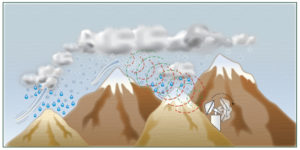Research
SAIL will deploy more than four dozen advanced atmospheric instruments measuring precipitation, aerosols, clouds, winds, radiation, temperature, and humidity across a wide range of spatial and temporal scales at the East River watershed research site. These data provide opportunities to quantify key physical processes in the Upper Colorado River Basin known for their qualitative impact on mountainous watershed hydrology.
Research Objectives
SAIL focuses on 5 interrelated science objectives in the Upper Colorado River:

SAIL will characterize the spatial distribution of orographic and convective precipitation processes on diurnal to seasonal time-scales and how those processes interact with large-scale circulation by using observations from an X-band scanning precipitation radar and the Ka-Band Zenith Radar (KAZR) at two separate locations to. Radar observations will provide detailed precipitation structure information that will be useful for observing embedded convective structures in wintertime storms, precipitation-type transitions, warm-season orographic convection, and transport of hydrometeors across mountain ridges. Doppler-derived wind fields will also provide useful information on airflow structures over multi-directional ridgelines. Coordinated Range Height Indicator (RHI) scans from the X-band scanning precipitation radar and the KAZR will yield multi-wavelength polarimetric radar observations to probe how hydrometeor microphysics and dynamics interact.
SAIL will establish aerosol regimes, the processes controlling the life cycle of aerosols in those regimes, and quantify the impacts of aerosols in those regimes on the atmospheric and surface radiative budget by combining the suite of measurements from the Mobile Aerosol Observing System with radiometric observations.
SAIL will quantify the seasonally-varying surface energy balance, the land-surface and atmospheric factors controlling it, and the spatial variability in those factors by using a suite of radiometric and cloud observations, and observations of turbulent fluxes of momentum, sensible, and latent heat to explore the dominant factors controlling these fluxes.
